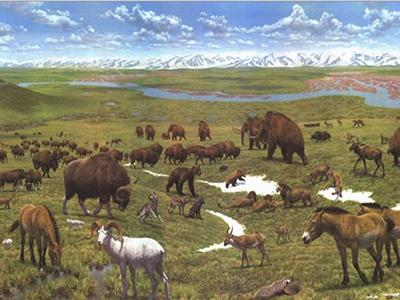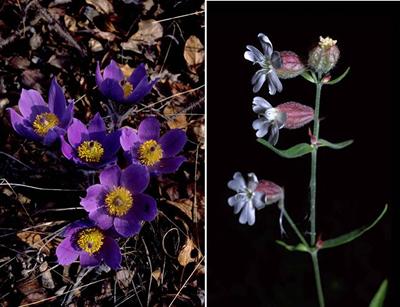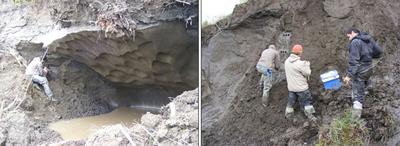A new, 50,000-year record of arctic vegetation history comes from the first study circumpolar study of plant diversity using DNA. The ancient DNA is found in permafrost sediments, the journal Nature reports today [6th February 2014]. The study adds important new information on the diet of the ice-age mammals. The DNA study reveals that the vegetation that the animals ate was dominated by forbs (flowering plants that typically occur along with grasses in tundra, meadow and steppe environments and are often rich in nutrients). This nutrient-rich dietary component meant better nutrition for the grazing animals than a diet rich in grasses and sedges—typical of modern steppe and tundra—would have provided.
Q. What were the ice-age megafauna and where did they live?
A. During the last Ice Age, which lasted for almost 100 000 years and ended about 12 000 years ago, the northern ice sheets greatly expanded – but some areas of the northern hemisphere were ice-free and covered by open, treeless landscapes occupied by a diversity of mammals every bit as spectacular as those inhabiting the east African savannas of today (the modern “megafauna”). This ancient ecosystem has now vanished and many of the animals vanished with it. Woolly mammoths, woolly rhinos, and several species of horse and bison were among the mammals that roamed the ice-age landscape, their numerous bones – and sometimes even mummies preserved in frozen ground – giving us a good idea of what they looked like. It is a far trickier thing to figure out what the animals ate and how they survived in the harsh ice-age climate.

Q. What is it thought that they ate?
A: What they lived on has to be figured out from the fossil evidence available. This comes from the remains of plants growing in the region: pollen, seeds, etc. The evidence suggests grasses, sedges and other non-woody plants were present. Based on comparison with the cold and dry regions of the planet today, scientists have concluded that the ecosystem was partly like steppe (seen in regions of central Asia) and partly like arctic tundra, but probably not quite like either, as the environment was different from that of any large areas of the planet today.

Q: How was the DNA obtained?
A: Vast areas of northern Yakutia in eastern Siberia are underlain by deep, permanently frozen sediments that represent the gradual accumulation of soil on the land surface over the tens of thousands of years of the ice age, when conditions were dry and dusty [link to Sussex]. The DNA comes from the roots and other parts of plants growing on the actual surface the mammals wandered across. It can be extracted directly from these sediments; DNA from the animals themselves is also present in the sediments. A further source of information is DNA analysis of stomach contents of mummies and preserved, frozen animal droppings known as coprolites.

Q: How are the plants identified?
A: The sequences of DNA that are recovered are compared with the DNA in a catalogue of modern plants that has been specially developed to study northern regions.
Q: What does the DNA show?
A: Both the soils and the animal stomachs and coprolites reveal much larger proportions of forbs than have been found in previous studies. This may reflect that other studies, which use, for example, the preserved parts of plants found in the soil, are biased away from forbs towards types of plants that most resist decay in the period before they become incorporated into the permafrost and finally frozen in place.

Q: What is the significance of the results?
A: Large amounts of forbs growing are not usually found in modern ecosystems that are dominated by large grazing animals such as bison. Ecologists studying the ancient ecosystem speculate under ice-age conditions, the grazing animals were part of a positive cycle in which their droppings fertilized the soil and enabled the forbs to flourish. At the end of the ice age, conditions changed dramatically, becoming warmer and wetter. These conditions no longer favoured the mammal-forb relationship, and other types of plant (such as woody shrubs and trees) began to dominate the landscape. This shift likely had serious consequences for the animals and may have contributed to the large number of extinctions that happened at the end of the ice age.
Further information
Mammoths lived in Britain in the ice age. For more information visit the Natural History Museum
Professor Dale Guthrie, based at the University of Alaska-Fairbanks, is an expert on the megafauna. He has written a fascinating book on the subject: Frozen Fauna of the Mammoth Steppe: the story of Blue Babe (University of Chicago Press).